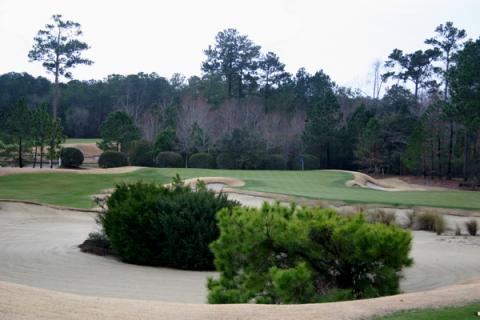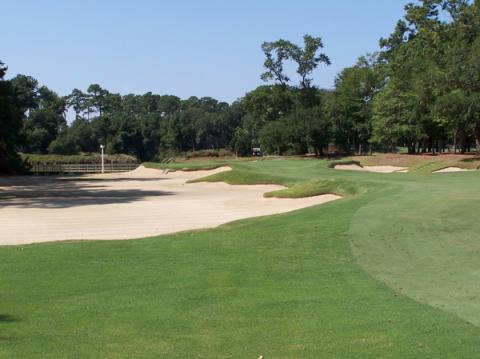Larry Nelson seemed a rather mellow fellow during his playing days on the PGA Tour, before he graduated to the senior circuit. But there is nothing mellow about the 27 holes he designed 10 years ago at The Centennial Golf Club, a challenging but somewhat exhausting track.
I played the Lakes and Fairways nines with a friend yesterday. He's a single-digit handicap and I'm, well, something a little north of that but able to hit a seven-iron typically 150 yards or so. We both came away from Centennial believing that, regardless of the tees you play - we played the blues at 6,500 yards - the approaches to some of the elevated greens were just too tough. And this was on a day of fairly steady drizzle, when the greens were not nearly as fast as they will be in the coming weeks. I don't think of myself as a golf masochist, and neither does my friend Bill, but we agreed we'd love to take another shot at Centennial in a month or two. That says something about the quality of a layout where neither of us broke 85.
drizzle, when the greens were not nearly as fast as they will be in the coming weeks. I don't think of myself as a golf masochist, and neither does my friend Bill, but we agreed we'd love to take another shot at Centennial in a month or two. That says something about the quality of a layout where neither of us broke 85.
We were a little taken aback by the first hole we played, #1 on the Lakes hole. I love starting with warm-up par 5s, but this was not exactly a hole on which to loosen up (click on schematic for larger view). Don't overcook a draw off the tee or you will find the water on the left. Assuming you negotiate your drive over 200 yards to a safe spot on the right side of the fairway, your lay-up with a mid to long iron will need to fly a narrow isthmus between the lakes to short wedge range from the green. A pulled approach sends you over the embankments and cart path on the left, and a push will have you swimming with the fishes before your day has begun. The first on the Lakes would be a much better hole if it were, say, the 5th; as the starter, it is a little brusque.
The rest of Centennial forces consistently accurate shots as well, and on a day when the air was heavy with a consistent mist, approach shots required a club longer than usual. Add another club for the green elevations and we found ourselves with a few head-scratchers from the fairways. The deep bunkers - I thought they had too much sand in them - and severe slopes at greenside made us contemplate our approaches even longer. When pins were toward the front sides of the firm, large and sloping greens, as they often were, it was difficult to keep shots from rolling to the back fringes.
After the Lakes nine, we thought we would get something of a reprieve on the Fairways. The course ranger described the Fairways as a "flat, more traditional" layout than the Lakes and the Meadows (we did not get to play the Meadows). The Fairways is indeed flatter, but by no means flat, with greens that were as significantly sloped as those on the Lakes. Looking back on our day at Centennial, I can hardly recall a green that was not multi-tiered or a tee that was anything but elevated.
significantly sloped as those on the Lakes. Looking back on our day at Centennial, I can hardly recall a green that was not multi-tiered or a tee that was anything but elevated.
For this time of the year in New York State, the course was in terrific shape, the greens smooth except for those lazy slobs who refuse to bend over to fix their pitch marks. Although we spotted a few oddly placed out of bounds stakes, the few homes we saw were nowhere near the course's boundary lines. Workers were all over the place, cutting grass and dragging a hose extended between two carts to "remove the mushrooms," as one explained to us.
The clubhouse and practice facilities at Centennial are of the private club type and, indeed, the club does offer annual memberships. (Note: The locker room is small.) The "premier" membership is a robust $5,500 annually. Good as the course is, you would have to play a couple of rounds per week on average during the seven-month season to justify the costs, and I just don't know if most golfers would want to put themselves through such a frequent challenge of having to bear down mentally on virtually every shot. Centennial, about 90 minutes north of New York City and convenient to I-84, is a wonderful golf course, especially in small doses.
Centennial Golf Club, 185 John Simpson Road, Carmel, NY. 845-225-5700. www.centennialgolf.com. Green fees: $100 weekdays, $135 weekend, cart with GPS included.


























